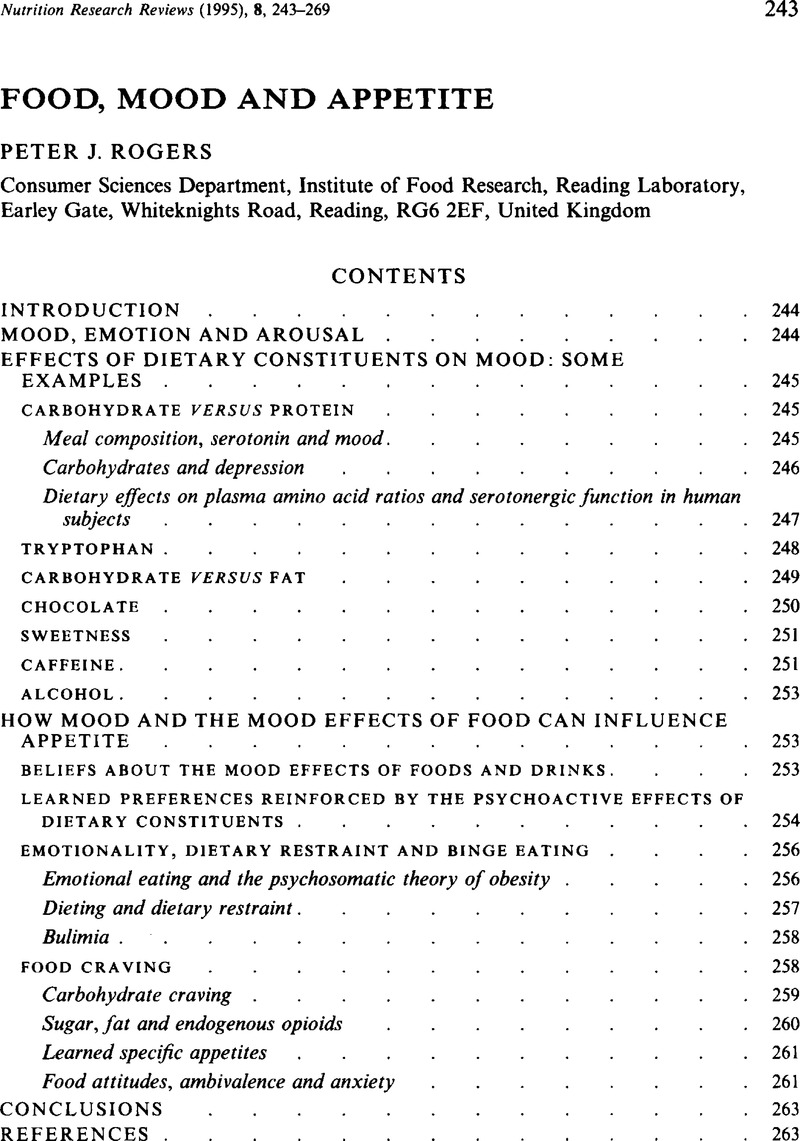Crossref Citations
This article has been cited by the following publications. This list is generated based on data provided by Crossref.
Powell-Tuck, Jeremy
1997.
Penalties of hospital undernutrition.
Journal of the Royal Society of Medicine,
Vol. 90,
Issue. 1,
p.
8.
Forbes, J.M.
and
Kyriazakis, I.
1997.
Meeting Report: Diet Selection in Animals and Man: Mini-Symposium of the Rank Prize Funds.
Appetite,
Vol. 28,
Issue. 2,
p.
185.
Reid, M.
and
Hammersley, R.
1998.
The effects of sugar on subsequent eating and mood in obese and non-obese women.
Psychology, Health & Medicine,
Vol. 3,
Issue. 3,
p.
299.
Bellisle, F.
Blundell, J. E.
Dye, L.
Fantino, M.
Fern, E.
Fletcher, R. J.
Lambed, J.
Roberfroid, M.
Specter, S.
Westenhöfer, J.
and
Westerterp-Plantenga, M. S.
1998.
Functional food science and behaviour and psychological functions.
British Journal of Nutrition,
Vol. 80,
Issue. S1,
p.
S173.
Mela, David J.
1999.
Food choice and intake: the human factor.
Proceedings of the Nutrition Society,
Vol. 58,
Issue. 3,
p.
513.
Reid, Marie
and
Hammersley, Richard
1999.
The effects of sucrose and maize oil on subsequent food intake and mood.
British Journal of Nutrition,
Vol. 82,
Issue. 6,
p.
447.
Rouvinen, Kirsti
Archbold, Shannon
Laffin, Sandy
and
Harri, Mikko
1999.
Long-term effects of tryptophan on behavioural response and growing-furring performance in silver fox (Vulpes vulpes).
Applied Animal Behaviour Science,
Vol. 63,
Issue. 1,
p.
65.
Rogers, Peter J
and
Smit, Hendrik J
2000.
Food Craving and Food “Addiction”.
Pharmacology Biochemistry and Behavior,
Vol. 66,
Issue. 1,
p.
3.
Fischer, Karina
Colombani, Paolo C.
Langhans, Wolfgang
and
Wenk, Caspar
2001.
Cognitive performance and its relationship with postprandial metabolic changes after ingestion of different macronutrients in the morning.
British Journal of Nutrition,
Vol. 85,
Issue. 3,
p.
393.
Rogers, Peter J.
2001.
A healthy body, a healthy mind: long-term impact of diet on mood and cognitive function.
Proceedings of the Nutrition Society,
Vol. 60,
Issue. 1,
p.
135.
Leigh Gibson, E.
and
Green, Michael W.
2002.
Nutritional influences on cognitive function: mechanisms of susceptibility.
Nutrition Research Reviews,
Vol. 15,
Issue. 01,
p.
169.
Macht, Michael
Gerer, Jutta
and
Ellgring, Heiner
2003.
Emotions in overweight and normal-weight women immediately after eating foods differing in energy.
Physiology & Behavior,
Vol. 80,
Issue. 2-3,
p.
367.
Smit, H.J.
Cotton, J.R.
Hughes, S.C.
and
Rogers, P.J.
2004.
Mood and Cognitive Performance Effects of "Energy" Drink Constituents: Caffeine, Glucose and Carbonation.
Nutritional Neuroscience,
Vol. 7,
Issue. 3,
p.
127.
Macht, Michael
2005.
Emotionsbedingtes Essverhalten: Die Bedeutung der Emotionen.
Zeitschrift für Psychologie / Journal of Psychology,
Vol. 213,
Issue. 1,
p.
9.
Williams, Emma
Stewart-Knox, Barbara
and
Rowland, Ian
2005.
A Qualitative Analysis of Consumer Perceptions of Mood, Food and Mood-Enhancing Functional Foods.
Journal of Nutraceuticals, Functional & Medical Foods,
Vol. 4,
Issue. 3-4,
p.
61.
Kazén, Miguel
2006.
Problemessen vs. Spaßessen.
Zeitschrift für Gesundheitspsychologie,
Vol. 14,
Issue. 2,
p.
34.
Parker, Gordon
Parker, Isabella
and
Brotchie, Heather
2006.
Mood state effects of chocolate.
Journal of Affective Disorders,
Vol. 92,
Issue. 2-3,
p.
149.
Smit, Hendrik J.
Grady, Melanie L.
Finnegan, Yvonne E.
Hughes, Sally-Anne C.
Cotton, Jacqui R.
and
Rogers, Peter J.
2006.
Role of familiarity on effects of caffeine- and glucose-containing soft drinks.
Physiology & Behavior,
Vol. 87,
Issue. 2,
p.
287.
Wardle, J.
and
Gibson, E.L.
2007.
Encyclopedia of Stress.
p.
797.
Kurzer, Mindy S.
2009.
Women, Food, and Mood.
Nutrition Reviews,
Vol. 55,
Issue. 7,
p.
268.



